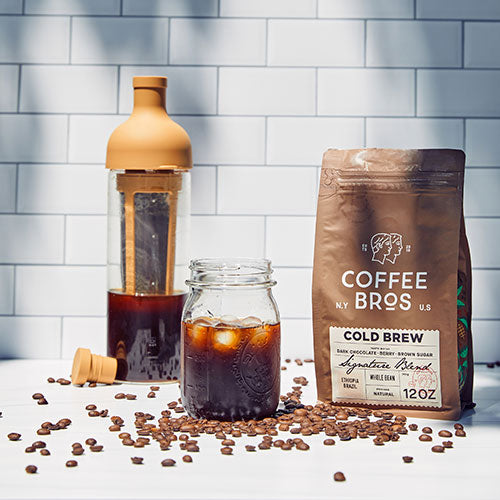Finding The Best Espresso Coffee Grinder
Introduction
If you made it this far, we could assume you are in the market for a great espresso grinder or looking to upgrade from your current one but may need to know where to start. We’ll break down how to find the best grinder for espresso, what features and functions to watch, and then toss you a few personal recommendations.
Table of Contents
Recommended Reading: Are you looking for the best espresso beans. Read our article on The Best Espresso Coffee in 2023.
What makes a good espresso grinder
Only some grinders can grind fine enough for espresso, and even those attached to your machine may need to do a sufficient job.
First and foremost, a coffee grinder for espresso must grind fine enough to brew an espresso properly. Espresso brewing is much different from any other brewing method as it involves finely ground coffee tightly packed into a portafilter that gets highly pressurized water (130 lbs. per square inch) pushed through it. Suppose your coffee is not ground fine enough to create resistance in your portafilter. In that case, the pressurized water will push through the coffee too quickly, causing an espresso that lacks viscosity and crema.
Grinding fine is only one piece of the puzzle, as the grinder's consistency, grind quality, ease of use, and features should also play a part in your purchasing decision. We’ll break down all these factors in the following few sections!
All about burr grinders
When shopping for espresso grinders, you often come across the term “burr” grinder. Burr grinders are the industry standard for espresso grinding and are placed into two categories: flat burrs and conical burrs. The type of burrs, the material they are made of, and their size all affect how consistent your grind will be and impact the taste of your coffee (RPMs of your grinder also play a part here).
Let’s look at Flat Burrs vs. Conical Burrs
Flat burr: A flat burr grinder features two horizontal blades, one positioned upwards and the other facing downwards. The coffee beans are placed between the burrs and ground, before being dropped and turned twice at 90 degrees.
In general, flat burr grinders tend to generate more heat and noise compared to conical burr grinders. However, they are also known for producing some of the most consistent coffee grounds due to their flat and large surface area, which leads to a smoother and uniform size. This results in a consistent taste in every cup of coffee.
Conical burr: Conversely to flat burr grinders, conical burr grinders work vertically, with one burr nested inside the other. The outer burr is shaped like a circular, hollow ring with slanted teeth, similar to a cupcake wrapper without the base. The inner burr is cone-shaped with a broader base, which appears star- or flower-like from above due to its channels and small angled teeth. The design of the burrs results in uniform grinding and high control over grind size, and is also highly efficient, leading to lower-speed grinders and less noise and heat generation.
After reading the above, you may still be confused about what burr type to look for when shopping for an espresso grinder. There is much debate about what type of burr is better for espresso. We have used both types and think conical burrs can produce a high-quality grind like flat burrs.
Mostly all café quality commercial espresso grinders use flat burrs, indicating the preferred burr type of baristas and coffee professionals. We’ll leave this one at that, as the debate between flat and conical burrs can be lengthy!
Espresso burr size differences
Choosing a grinder based solely on burr size may lead you to purchase a grinder that is not the quality you want. We compiled a list of espresso grinders by price, burr type, burr size, and average rating to show you that often, the size of the burr correlates to price, which leads to the misconception that bigger burrs are better burrs.
Larger burrs, as you may have guessed, have a larger surface area, meaning they can grind espresso more efficiently than their smaller burr counterparts. As you can see below, the larger burrs tend to be in the higher-priced bracket as they often need larger motors to power the system. These grinders are usually geared toward the café setting and not the home espresso enthusiast.
Regardless of burr size, you are looking for a grinder that grinds consistently across a given grind setting. The grinder you choose should produce an even distribution in grind size, as this is what typically impacts the coffee’s flavor the most (as well as RPM and heat produced from the burrs). A grinder that produces a lot of “fines” or an inconsistent grind size means that your brew will extract unevenly and inconsistently every time.
| Grinder | Price | Burr Type | Burr Size | Average Rating |
| Breville Smart Grinder | $199.99 | Conical | 40mm | 4.7/5.0 |
| Rancilio Rocky | $440.00 | Flat | 50mm | 4.4/5.0 |
| Eureka Mignon Silenzio | $479.99 | Flat | 50mm | 4.5/5.0 |
| $599.99 | Conical | 40mm | 4.8/5.0 | |
| $649.99 | Flat | 55mm | 4.7/5.0 | |
| Eureka Oro Mignon Single Dose | $799.99 | Flat | 65mm | 4.1/5.0 |
| $800.00 | Flat | 50mm | 4.9/5.0 | |
| Mazzer Mini | $820.00 | Flat | 58mm | 5.0/5.0 |
| Rocket Espresso Fausto Touch | $1,300.00 | Flat | 65mm | 4.9/5.0 |
| Mazzer Mini E Espresso Grinder | $1,300.00 | Flat | 65mm | 4.4/5.0 |
| Eureka Atom 75 | $1,399.00 | Flat | 75mm | 4.9/5.0 |
| Mazzer Super Jolly | $1,470.00 | Flat | 64mm | 4.8/5.0 |
| Mahlkonig E65S | $2,300.00 | Flat | 65mm | 5.0/5.0 |
Burr material differences
You will mostly find titanium burrs on the market, though ceramic burrs do exist. The main differences are their distribution of fines, heat retention, durability, and price.
Titanium burrs are reliable and can grind thousands of pounds of coffee before needing replacement. You will likely never need to replace titanium burrs for a home espresso enthusiast.
Titanium burrs produce a very consistent grind that produces very few fines. That means your grind particle size is relatively consistent, producing a clean and sweet flavor profile.
Finally, titanium burrs heat very slowly but have difficulty cooling quickly compared to ceramics. If you are grinding much coffee often and quickly, titanium burrs may impact the flavor profile of your coffee as they heat up and retain heat.
Ceramic burrs are said to produce more fines, leading to a more complex flavor profile, often with heavier body and mouthfeel (more fines often mean higher total dissolved solids (TDS) but does not always lead to a better flavor profile).
Grind adjustments
Finding an espresso grinder with infinite or stepless adjustments is crucial when dialing in a coffee for espresso. It is ideal to have a grinder like the Eureka Mignon Specialita that has an endless adjustment; a slight turn of the knob and you are at a whole new grind size, but it does make it more challenging to keep track of precisely what setting or grind size you are on. We have worked with grinders like the Baratza Sette 270wi, a step/stepless adjustment grinder with 30 macro steps and 9 marked micro stepless adjustments, which grinds beautifully and is easy to dial in espresso.
Both grinders are moderately priced but give you an almost endless grind adjustment to easily fine-tune from one espresso to the next.
Grind Size Range
Another essential factor when looking for the best espresso grinder is the grind range. The grind range ultimately indicates how fine or coarse your grinder can grind through the stepped or stepless adjustments you make. Every espresso grinder should tell you its range, where the lower end represented in microns will indicate how fine it can grind up how coarse.
Below are some examples of grind size ranges represented in microns. Remember, grinders with step adjustments may adjust between ~8 – 15 microns per click, while stepless grinders have no set micron adjustment.
| Grinder | Grind Range |
| Baratza Sette 270wi | 230 – 950 μm |
| Mahlkonig E65S | 180 – 580 μm |
| Mahlkonig X54 | 200 – 1,000 μm |
*grind range figures are often difficult to find and many grinder manufacturers do not list them
The crucial thing here is to find a grinder that falls within the espresso range of 200 – 500 μm. Anything under 250 is typically too fine, and over 400 is usually too coarse for espresso.
Grind by weight vs. grind by time grinders
- Grind-by-Weight GbW grinders: Grind-by-weight grinders do precisely what you think they might. You set the desired weight in grams, hit the grind button, and a few seconds later, you have close or exactly how much ground coffee you need in your portafilter. Most high-end commercial grinders like the Mahlkonig E65S GbW have this feature, but it can also be found in the Baratza Sette 270Wi, powered by acaia technology.
- Grind-by-Time GbT grinders: Grind-by-time grinders are what you’ll find most on the market and do a decent job of achieving your desired weight, but they can sometimes be frustrating. Grind-by-weight grinders work by setting the amount of time you want to grind. For example, I know 4.5 seconds on my Mahlkonig E65S will produce roughly 20 grams of coffee for a double shot of espresso for a particular coffee and grind setting. Every time you adjust your grind setting or change your coffee, you must adjust the time. Luckily, most GbT grinders have a pulse button where you can stop the grind short, measure, and then pulse a few more grams of coffee into the portafilter if needed.
Note that GbW grinders are typically only found in high-end commercial espresso grinders though the Baratza Sette 270Wi has this feature and is reasonably priced.
Most grinders under $2,000 are grind-by-time, so searching for a good quality GbW grinder different from the Baratza Sette 270Wi will leave you with few options.
RPMs and extraction
Much recent conversation has been around the speed of your grinder and how that might impact the ground consistency (more or fewer fines), ultimately impacting flow rates, extraction, and taste.
There is still inconclusive evidence on how the RPMs (faster or slower) of your burrs impact total cup clarity, but a few observations are worth mentioning.
Higher RPMs mean your grinder will get the job faster, but at what cost? The thought is that higher RPMs may produce more fines leading to a cup with lower clarity. On the other hand, a slower grind has been seen in some observations to produce fewer fines and a potential for more even extraction.
Grinders like the Weber Workshops (The Key) have varying RPM settings ranging from 30 to 150. 30 RPMs replicates that of hand grinding, though without the stuttering that may occur when using a hand grinder. There is some excellent information on The Key grinder and how varying speeds much lower observationally improves cup clarity and taste.
While we will not go much further into this topic, note that the RPMs of your grinder will impact grind consistency and clarity, but to what extent is quite challenging to pinpoint. Only a few grinders on the market have easily adjustable RPMs, but keep an eye out for these as new players or upgraded grinders come with this feature.
Hopper grinder vs. single dose grinder
- The angular design is another method to help reduce grind retention of grounds in the chute.
- The angular design also helps push coffee beans into the grinding chamber as there is no added weight of additional coffee above, like in a hopper-style grinder.
- Popcorning is another thing that single-dose grinders must worry about by not weighing coffee in a hopper. If you have ever seen coffee pop around in your hopper when you are toward your last dose, this is what is referred to as popcorning. Single-dose grinders try to prevent this with an angular design, as popcorning leads to inconsistency in the grind.
Low grind retention
A grinder with close to zero grind retention is what everyone is looking for. If you read the previous section, single-dose grinders with their angular design and added bellows mostly solve this problem though no grinder is perfect.
We always point readers toward the reviews of a grinder, as many like yourself are looking for a grinder with close to zero retention.
There are many great options on the market but note that this is a feature you should look for.
Anti-static measures
Even the highest-end espresso grinders will have static issues. If you have ever ground coffee and the grounds spray out at different angles, then you have dealt with static issues.
There are a few ways of preventing this, and another reason why some turn toward single-dose grinders. A light spritz of water on your coffee beans before grinding will almost always eliminate static electricity. Unfortunately, you cannot do this is a larger hopper-style grinder, and you will have to rely on their internal anti-clumping/anti-static measures.
Higher-end grinders have a flap that the coffee grounds must push through before coming out of the chute into your portafilter. The flap, often made of rubber or metal material, slightly slows down the grounds causing resistance and usually reducing or eliminating static electricity.
If your grinder is starting to experience static issues, the most common culprit is a grinder that needs cleaning. Watch a few videos on how to clean your grinder, and once completed will usually solve any static issues.
When shopping for a grinder, note that if it is a hopper-style grinder, some measure is being taken to help prevent static electricity. If you are in the market for a single-dose grinder, note that you can use the Ross Droplet Technique and spritz the coffee with some water.
Digital control and display
Digital controls and displays are standard on most hopper-style grinders, but you won’t find them on the smaller single-dose grinders.
The main perk of a digital display is that you can often set a few recipes, maybe one for a single shot and another for a double.
A lack of digital control and display should not be a make or break when shopping for an espresso grinder, but again it is a nice added feature.
Build Quality
Build quality is more than just the external casing that your grinder sits in. You’ll find plastic, aluminum, and stainless steel as the materials of choice for the external frame of the grinder.
You will want to keep your eye out for mentions of the wattage of the motor, as higher-wattage motors will be able to push through grinding coffee easier and not get clogged or stuck as often. The higher watts don’t necessarily mean it is a higher quality motor, as determining that is somewhat difficult.
Also, keep an eye out for any sound-reducing measures and insulation or rubber elements added to the internal body of the grinder, which helps produce a quieter grind.
As mentioned in our prior section, know the differences between burrs and burr material.




